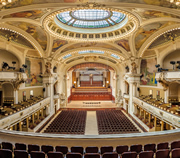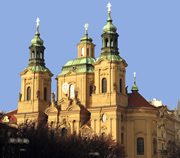| | |
| | |
Welcome to Prague: Prague Information & City Guide
Prague is the 'Jewel in the Crown' of Central Europe. Tourism has played an important role in its economic development, transforming run-down buildings into fine restaurants, stylish hotels, vibrant bars and pumping clubs.This guide introduces you to Prague, explains the layout of the city, covers its sightseeing and entertainment highlights, and has information on where to stay. |
| | | |
Welcome to Prague
Prague is the capital city of Czechia (Czech Republic). The country lies at the heart of Central Europe, and is bordered by Austria, Germany, Poland and Slovakia.
In the Middle Ages, Prague became the capital of Charles IV's Bohemian Kingdom, with Prague Castle the seat of the empire. The city has played a pivotal role in the region ever since. Prague's epic history has produced a city full of beauty, of stunning Gothic, Renaissance and Baroque era buildings, and of majestic squares. | |

Prague Castle |
| | | In modern times, the statist communist era of the mid-20th century has given way to dynamic capitalism. Tourism in Prague has helped drive its regeneration, transforming grey, run-down buildings into fine restaurants, stylish hotels and vibrant bars; a virtuous circle, which encourages an ever greater number of tourists to visit the city.
Prague Tourism Fact: In 1992, the entire historical centre of Prague, all 866 hectares, was listed in the UNESCO World Cultural and Natural Heritage Register. | | 
Old Town Square in Prague | |
Prague Highlights
The city centre is compact and the finest areas are mostly pedestrianised, so Prague is best explored on foot; from Wenceslas Square on one side of the city to Prague Castle on the other is just a 30-minute stroll (walking via the Old Town, across Charles Bridge, and through the Lesser Town).
The first thing to do in Prague, therefore, is simply to wander through the cobbled streets and magnificent squares. Admire the stunning architecture and revel in the unique ambience. |
| | | Prague is a city to immerse yourself in, look to discover interesting places, and to eventually find a nice café or pub to stop off for a drink at; all the time letting the worries of the world dissipate.
Tip: If you are the kind of person who likes to know what you are looking at, then perhaps more than in any other city in Europe it is worth taking a sightseeing tour early in your trip. A local guide can show you to the main sights and attractions, and explain the history and significance of everything you see. You should find it an informative, yet highly entertaining activity, and it will set you up for the rest of your visit. | |

Prague river cruise |
| | | Making your way around Prague, your travels will soon lead you to the Vltava River, which runs through the heart of the city. Walk along its banks and over Charles Bridge to enjoy wide panoramic views across the water. | | | | | For a typically Czech experience, black light theatre is a unique feature of Prague. Shows are fast moving and highly visual, with little or no words spoken. They appeal to all ages and nationalities.
Turning to refreshments, Prague enjoys a reputation for offering excellent food and drink to suit every budget.
For something truly special, there are fine dining restaurants set in the most beautiful locations, such as by the river, in historic buildings, or with views over the city.
For every day dining, Czech and pub style restaurants serve hearty food and fast flowing drinks at very reasonable prices. | |

Smetana Hall, Municipal House |
| | 
Old Town Square at night | |
Appropriate for consumption any time of the day, the world famous Czech beer is deeply embedded in the national physique, and is enthusiastically consumed in cafés, pubs and beer halls throughout the city; the Czechs are the largest consumers of beer per capita in the world!
While the warm, cosy pubs may draw you in in the winter, on sunny days the action moves outside. Take a seat on the terrace or in the beer garden at one of the many bars or cafés, order a cold beer or chilled glass of Moravian wine, and watch the world go by. You will find time just slips away!
For a non-alcoholic treat, join the locals at one of Prague's elegant traditional cafés, where coffee or hot chocolate and cake or is the order of the day. |
| | | Inevitably, at some point in your trip you will wish to buy something tangible, whether that be a tourist souvenir or a new dress. Well, you are in luck.
Tourism and business investment has boosted the Czech economy dramatically in recent decades, which has led to increased consumerism, making shopping a national pastime!
Prague boasts a wide variety of shops and department stores, selling both local and international branded clothing and apparel.
The largest shopping mall in the city centre is Palladium, but shops can be found throughout the city centre, especially around Wenceslas Square and along the pedestrianised shopping street, Na Příkopě.
In terms of locally produced goods, Czechia is famous for producing Škoda cars, Czech beer, and the finest glassware under the name Bohemia Crystal. Moser Glass and Erpet Bohemia Crystal are just two of the well known glass shops to be found in Prague.
To visit the town where Moser Glass is produced, the Karlovy Vary Tour is a day trip from Prague. | | | | | Charles Bridge is the main pedestrian route that links the two sides of Prague, connecting the Old Town to the Lesser Town (and ultimately Prague Castle).
The sights, tourist attractions, entertainment and nightlife are spread across all five areas of Prague 1, and it is easy to walk between them all. | |
Where to Stay in Prague
Prague 1 is the best place to stay in Prague.
Book a hotel in any of the five areas within Prague 1, and it is possible to explore the entire city centre on foot.
The two most popular areas within Prague 1 to stay in are the Old Town and the New Town. Next is the Lesser Town, from which you can easily reach the Old Town and the New Town by strolling across Charles Bridge.
There are a lot of hotels in Prague 1, so room rates are highly competitive.
Prices in the other districts of Prague are cheaper, and from most of them the journey into the city centre by public transport (metro and tram) is straight forward.
Public transport is particularly good in Vinohrady and Vysehrad (Prague 2), Smichov (Prague 5), Holešovice (Prague 7) and Karlin (Prague 8). Many of these outlying areas have an up-and-coming vibe, and all offer a variety of local shops, bars and restaurants. | | | | | To dine with a view, see restaurants with a view or riverside restaurants. | | | | | For the full list, view our guide to the Prague sights and tourist attractions. | | How Many Days in Prague
3 full days or around 72 hours is an ideal length of time to spend in Prague. This allows enough time to explore the main sights and attractions, enjoy leisurely food and drinks breaks, and experience a flavour of the evening entertainment and nightlife on offer.
While the most popular hotel stay in Prague is 3 nights, many visitors fly in for a whirlwind 2-night city break, and others opt for a more leisurely 4-night or even 5-night stay.
Flight times can be a major factor in deciding the number of nights for your trip: Arrive in Prague in the morning on day one, and you can be out exploring the city in the afternoon, and enjoying dinner and drinks somewhere nice in the evening. In contrast, arrive late at night and you won't be able to explore too much, so you will probably need an extra night. | |
Czech Language
Czech is a consonant-rich Slavic language. It is considered to be one of the most difficult European languages to learn by speakers of Latin and Germanic based languages. Native English speakers can find certain sounds very hard to pronounce.The requirements of tourism and globalisation ensure that many Czechs in Prague speak English, particularly the younger generation. | | 
Wenceslas Square in Prague | |
Czech Phrases & Pronunciation
Good day / Hello = Dobrý den (Dobree den)
Good evening = Dobrý večer (Dobree ve-chair)
Goodbye = na shledanou (Naskledanou)
Hi / Bye = Ahoj (Ahoy)
Yes = Ano (Ano)
No = Ne (Neh)
Thank you = Děkuji (Dyekooyih)
Cheers = Na zdraví (Na-zdra-vee)
Where's the toilet? = Kde je záchod (kdeh-yeh zaakhot)? |
| |
Prague in Czechia
Czechia (Czech Republic) covers 78,864 square kilometres (30,449 square miles), and is divided into 14 regions. Prague is in Central Bohemia, the largest region.
The highest mountain in Czechia is Snezka (1604m).
The longest river in Czechia is the Vltava River (434km), which flows from the Bohemian Forest in the south of the country to meet the Elba at Mělník in the north. On its journey, the Vltava passes through Prague. |
|

Czechia (Czech Republic) in Europe | | |
Czech People
The population of Prague is 1.3 million. The population of Czechia is 10.7 million.
Czechs belong to the West Slavic group of peoples, along with Poles, Slovaks and Lusatians.
Romanies (or Gypsies) form the most conspicuous minority in the country, and are thought to descend from Indian migrants in the 15th century. | |

St. Nicholas Church in Prague | |
Recent Migration and Visitor Numbers
In recent years, a sizeable number of people from Central and Eastern European countries have migrated to Prague to work in the booming tourism and construction industries.
Prague tourism is hitting record highs. Around 7.5 million tourists visit Prague annually, with the number of visitors increasing by nearly 10% each year.
The largest number of tourists are from Germany, the United States and Great Britain.
The highest percentage increase is in tourists from Asia, as Prague Airport expands, and opens more direct flights to key Asian cities. |
| |
Religion in Czechia
Christianity is the dominant religion in Czechia. The Roman Catholic Church is the primary church. There are several Protestant denominations as well, such as the Evangelical and Hussite churches. | | | |
More Information
For more practical information, including advice on when to visit Prague, the weather, what to wear, and currency exchange: Prague tourist information.For travel information: Travel around Prague by public transport and Travel to Prague. For an easy way to visit Prague, the Prague Package includes a hotel, Prague airport transfers, sightseeing and entertainment.
If you have any questions, don't hesitate to contact us. |
| |
| |
|
 CURRENCY GUIDE CURRENCY GUIDE |  | | £1 = 29 CZK |
| |  | | €1 = 25 CZK |
| |  | | $1 = 23 CZK |
|
|
|
| |
| |
|